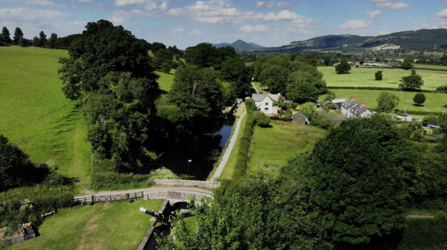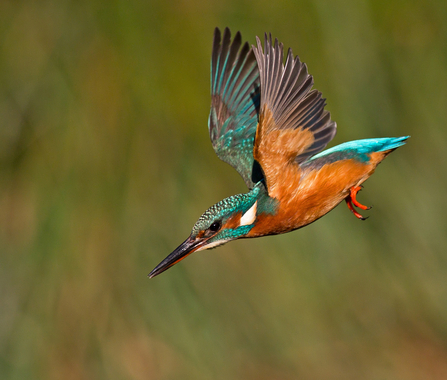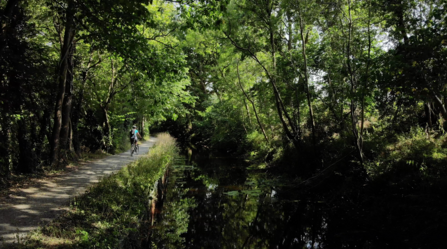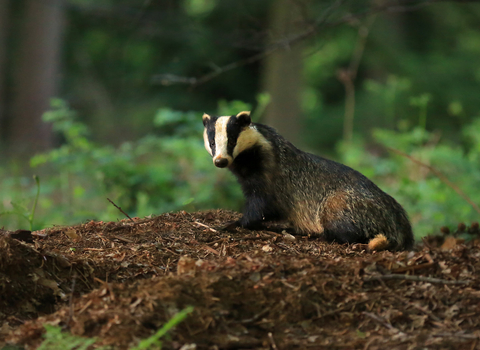This wildlife haven is under threat
A thriving ecosystem packed with rare plants and scarce species; a year-round refuge for otters to feed and play; and, in summer, a bustling insect highway, alive with bees, butterflies, dragonflies and damselflies, the Montgomery Canal is one of the best canals for nature in the UK.
But The Monty is under threat. Plans are underway to open up the entire Welsh section – 24 miles of wildlife-rich waterway, which runs from Llanymynech to just outside Newtown, via Welshpool – to motorised boats, as part of a multi-million project financed by the UK Government’s Levelling Up fund. Allowing motorised boats on this canal would be catastrophic for much of its wildlife.

Credit - Flying Film Lab ©
How can I help?
Permitting the sort of damage that motorised boats would inflict on an SAC, which is protected by law, would set a worrying precedent for decision-making in Wales. But you can speak up for this important habitat by telling decision-makers why the Montgomery Canal's wildlife matters to you and backing our calls for sensitive, appropriate restoration and halt plans to allow motorised boats on the Montgomery Canal. It's easy to make your voice heard - just complete our e-action:
Why's the Montgomery Canal so special for wildlife?
While the canal starts in Shropshire near Ellesmere, the majority of its length lies in Wales. This Welsh section is a Site of Special Scientific Interest (SSSI), as well as being a Special Area of Conservation (SAC) – a designation given to the most important places in the UK for wildlife that are also of international significance.
Its SAC status is primarily for aquatic plants – the waterway supports the largest and most extensive population of the internationally rare Floating Water-plantain in Britain, as well as habitat for other rare plants such as Grass-wrack Pondweed. Around 10 species of dragonflies and damselflies also breed here – including scarce species like the Common Club-tail dragonfly and the White-legged Damselfly. What’s more, the canal is an important feeding ground for otters, kingfishers are frequently seen along its length and bats such as Daubenton’s and Common Pipistrelle roost in its bridges.

Credit - © Richard Lansdown/Wildscreen Exchange
It’s a combination of factors that make the Montgomery Canal an important place for such a variety of wildlife. Like most rural canals, it’s a vital wildlife corridor, enabling birds and animals to move around safely. Then there’s the mixture of different habitats – slow-moving water, verge, hedgerow, reedbed, bridges, crevices in locks and scrubland. But the Montgomery Canal is also very special for the clean, clear quality of its water – something that makes it very attractive to an abundance of creatures, but particularly freshwater species.
Some of this could well be because the majority of the Welsh section has been unnavigable since the canal officially closed to boats in 1944 – with the exception of small, isolated sections in Llanymynech and Welshpool. But it might also be connected with the fact that historically The Monty didn’t experience the high levels of boat traffic other waterways did, and steam tugs and diesel boats allegedly never used it.
Why is the restoration important?
The Montgomery Canal does need some maintenance for its biodiversity. Currently, a lack of funding means it’s difficult to maintain the ideal depth and width of open water required for many of its precious plants and freshwater animals. Part of the proposed restoration would include dredging, which is necessary to restore the canal’s open water conditions and maintain water flow, as well as possibly improving water quality, to safeguard the future of the Floating Water-Plantain and other aquatic life. Similarly, any sympathetic improvements to the towpath and anything else that enhances the visitor experience to the canal, and helps bring people closer to the wealth of wildlife it supports, without harming the natural environment, can only be a good thing for the local community.

Kingfisher © Malcolm Brown
Why are motorised boats such a problem?
While much of the English section of the canal – from Ellesmere in Shropshire to Llanymynech – is navigable by boat and connected to the main canal network, the majority of the Welsh section (with the exception of separate stretches in Llanymynech and Welshpool) remains unnavigable and isolated from the national network.
Part of the proposal for the restoration of the Montgomery Canal in its entirety is that it would make the waterway navigable to all kinds of water vessels, including motorised boats. These pose a threat to the canal and its wildlife for several reasons; the boat propellors damage and destroy plant and animal life; they increase turbidity (when the water is cloudy with mud, reducing light levels needed for animal and plant life); they create wake, which breaks up rafts of floating aquatic plants; and they often cause pollution with fuel and waste water. That’s to say nothing of the noise and its impact on birds and mammals such as otters and Water Voles.
This was found to be the case along the Shropshire stretch of the Montgomery Canal, where opening up to motorised boats resulted in numbers of water plants and invertebrates that live in the water declining. The Aston Locks to Keeper's Bridge part of the canal was designated as a SSSI in 1986. It was restored and reopened in 2003 and by 2013 Natural England reported that the site was in an unfavourable condition due to the public access, associated disturbance and pollution.
What’s the alternative?
The Montgomery Canal is a wonderful place where people can get close to, and appreciate, nature. In addition to walking and cycling, low impact activities such as canoeing, kayaking and stand-up paddleboarding, on a small scale, would enable visitors to enjoy the canal from the water, without too much disturbance. We would also advocate for the use of horse-drawn boats, like are used on the Llangollen Canal, as these boats do not have motors or propellors and are much slower moving so they create no wake.

Credit - Flying Film Lab ©
FAQs
Here are some frequently asked questions and answers about the canal's proposed restoration plans
Q: What’s Montgomeryshire Wildlife Trust’s relationship with the Montgomery Canal?
A: The Montgomery Canal is owned and managed by Glandwr Cymru, Canal & River Trust in Wales. However, MWT have a long and special relationship with the canal. It runs through the county like an artery, linking up many of our nature reserves; 9 of our reserves are within the canal corridor (5km either side of the waterway) and 5 of these are in very easy walking distance or located just off the canal towpath. We have carried out considerable conservation work, such as wildlife surveys, and litter-picking along its length over the years. What’s more, thanks to its SSSI and particularly SAC status, we’re passionate about its protection – as it’s one of Montgomeryshire’s most important places for nature.
Q: Wasn’t the Montgomery Canal originally built for motorised boats?
A: You could be forgiven for thinking this, but actually the canal pre-dates motorised boats, Construction commenced in the mid-1790s and the entire waterway was opened in 1819. At this time, wooden horse-drawn narrow boats would have been used on the waterway to transport lime and coal around the county. Motorised vessels were not introduced in the UK until the late 19th century with steam power, and then gas and diesel motors from the turn of the next century. It’s believed that because the Montgomery Canal’s use was already in decline by this time, steam tugs and diesel boats never travelled on it. Despite the canal's origins as a means of transporting agricultural and industrial materials, it has since evolved into an incredibly important place for wildlife at a time when nature is in crisis and every remaining wildlife refuge is immeasurably precious.
Q: Aren’t there off-line nature reserves planned that will off-set any damage caused by motorised boats?
A: Several linked off-line reserves were created in the 1970s when restoration work on the canal first started. This was done to protect examples of the habitats and species found in the canal. Sadly, these reserves have failed to replicate the conditions of the Montgomery Canal that enable rare species to thrive and the transplanted populations have died out.


